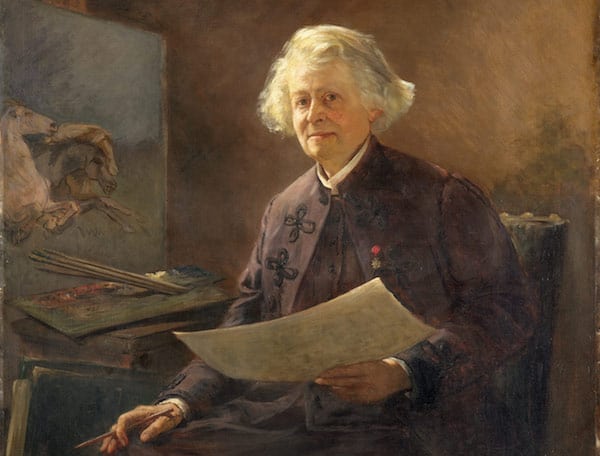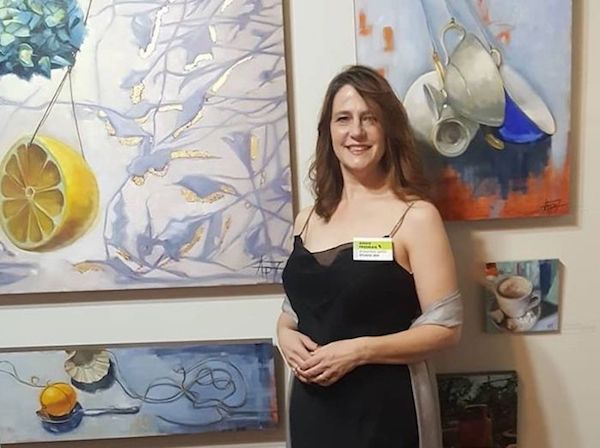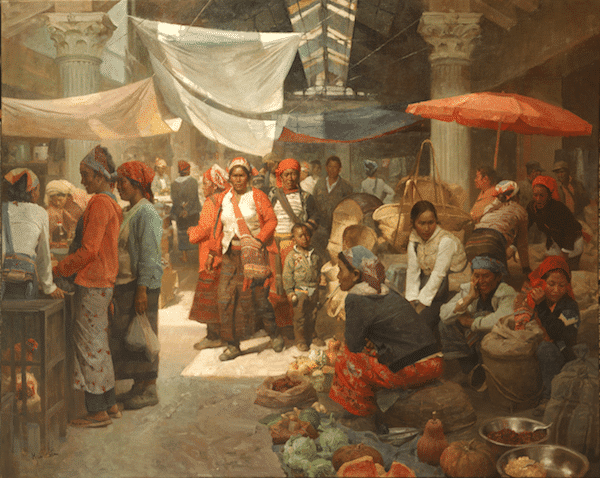
On August 31, 2016, the Clark Hulings Estate officially unveiled its comprehensive archives, showcasing the late artist’s immense talent, accomplishments, and influence. The impressive collection, which includes Hulings’ paintings, drawings, historical insights, and resources, is now publicly available online through the relaunched ClarkHulings.com website, social media, and related resources.
In a recent interview with CHF Editorial Director Sofia Perez, CHF Director and Co-Founder Elizabeth Hulings discussed the value of her father’s archives as a case study for other artists and their heirs, and the many ways that one must vigilantly protect an artist’s legacy and business interests after that artist has passed away.
SP: Let’s start by having you give us an overview of the new website.
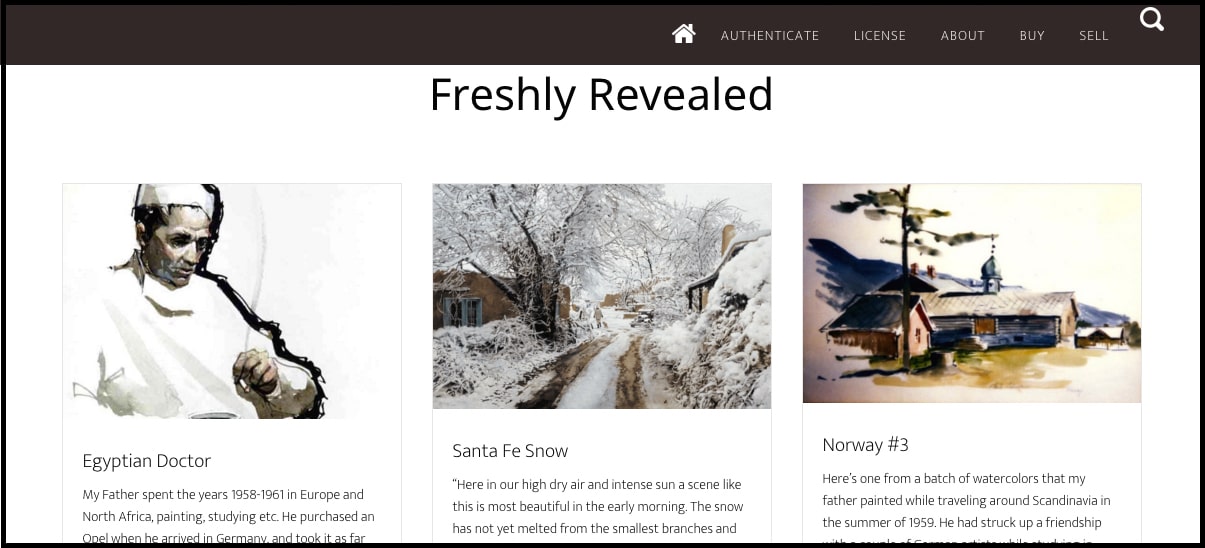
EH: It presents things in a new and different way: Clark Hulings as an artist, Clark Hulings as a man in his time, why he painted what he painted, and why that matters. There are galleries of his work, and the site addresses the significance of these pieces. Not just his oil paintings but his whole body of work—drawings, works on paper, illustrations, things that have never been presented before.
There’s also a section where you’ll be able to acquire reproductions of his paintings. We have giclées, we have ephemera, we have catalogues—all kinds of things for anyone who’s interested in his work, and who would like to own it in some form.
This site is intended for fans. There’s plenty of new stuff that we haven’t put out before. We’re taking kind of a different tack with a lot of this material. I have committed to creating a new post every week featuring a different painting, with information that hasn’t been published on the web before. That doesn’t mean a particular painting has never been circulated, or that people haven’t seen it in a book or somewhere else, but it’ll be the first time that this writing about it will appear on the web.
These posts will include writings by Clark Hulings—what he had to say about various paintings—and I’ll add my own history to his words. And sometimes, it’ll work the other way: there will be an image of a work that I want to know more about. It will help me gather additional information.
SP: There’s also an entire section dedicated to assisting collectors.
“…The work we’re doing with the [Clark Hulings] estate is absolutely a living example for artists of what they can accomplish if they do the things we recommend…”
EH: Yes, if you own a piece by Clark Hulings, we want to help you make sure that it’s properly appraised so that you can insure it. Or maybe you just want to know more about a specific work. We can help you with research. For people who are trading Hulings’ pieces, we can assist with authenticating and valuing them, as well as with strategy and getting the word out to our network of potential buyers—people who have already demonstrated interest in his work. Finally, you’ll be able to consign the work to us, and we’ll take care of getting it sold for you in the most advantageous way.
If someone reaches out to say, “I have a painting called The Blue Barn. What can you tell me about it?” I don’t want to say to them, “Nothing, sorry. Call somebody else.” I’m not going to do that. If you have a painting and you need to do something with it, why not seek the help of those who have the official records and who’ve been working with Hulings’ paintings for decades?All of these people can benefit from my extensive background with this particular artist—all the research, the materials I have at my disposal, and the team I’ve put together. Collectively, we’ve spent 40 years working on Clark Hulings’ artwork, in the marketplace and everywhere else.
SP: Is that what drove you to redo the website?
EH: Well, for starters, it was time for a refresh, but I also wanted to make the site a real resource for anyone who has a Hulings painting and wants to sell it, get it appraised, know more about the story behind it, etc. The new site will be very useful to those people.
It’ll also be a resource for me, because part of the legacy that sits on my shoulders is managing my father’s catalog and archives. I hope that people will share information with me about the Clark Hulings work that they own.
When it comes to the book covers he illustrated, for example, there are many originals I’m missing. By publishing those images, I’m hoping someone will say, “Hey, I own that,” and I’ll be able to ask, “Who are you? Tell me all about it!” The easier it is for folks to get me that information, the better off we are. It helps to ensure that the estate’s records are complete.
SP: Why does that matter so much?
EH: Well, I’m the only daughter of an artist. So guess what? This is on me. I also happen to do business strategy for a living, and I started this nonprofit organization to help artists with their businesses. That includes taking care of these kinds of things for the future: inventory, collection management, record-keeping. Whoever inherits an artist’s work and ephemera—and all of the responsibility that goes along with that—needs to keep track of it and make sure it doesn’t get lost.
When you acquire a work of art, you hang it on a wall, and it’s lovely, but you’re also responsible for it. Someone created that work of art, and if you love it, a lot of other people are going to love it, too. You have an obligation to safeguard it and display it.
Furthermore, when you’re responsible for an artist’s entire legacy, as opposed to simply owning one piece, there’s a further obligation to make sure—to the extent that it’s possible—that correct and substantive information is known about that artist’s body of work.
SP: You’re taking charge of protecting his legacy.

EH: Yes. I am not just going to turn over my father’s archives to a museum or somebody else. Several different places have asked. They even started asking him ten years before he died, and he said, “No, it’s going to my daughter.” I don’t want to be uncharitable about this, but I’ve said no because, most of the time, this kind of stuff just ends up in a basement somewhere.
I have a responsibility to continue to try to get his works curated into museums at higher and higher levels, to make sure that this artist is recognized as a master American painter. One way to do that is by staying in the marketplace, keeping track of the secondary market and the provenance of all his works, and assisting the people who are trading his paintings—whether they’re collectors, private dealers, gallerists, representatives of auction houses, or people who inherited a painting from Aunt Sally that they didn’t even know she had.
SP: The estate seems like the natural resource for those folks. Your interests are aligned with theirs—namely, protecting the value of the work.
EH: Yeah, that’s part of it. You’ve heard my story, Sofia, about a couple of his paintings that went up for sale recently, where the people who were selling them had clearly not done any homework. There are three things that typically happen when this process goes wrong, and this applies to the sale of work by any artist, not just Clark Hulings.
Number one: The seller doesn’t do their homework before the sale. They fail to get the word out or research the work, to know why it’s important and how it should be properly positioned, and line up potential buyers for it—the people who would naturally be interested in the work of that artist. The seller just throws a piece out there, putting it up for sale without determining appropriate price points. It’s silly and self-defeating because they’re taking money out of their own pockets as well.
Number two: They flood the market with stuff, or repeatedly put something up for auction at the wrong price, or without having lined up buyers, and then when the piece doesn’t sell, they do it all over again six months later. How many times does that happen before everyone else thinks, “Gee, that must not be a very good painting”? That may not be the case at all; it might be a stupendous painting, but the seller has burned it by not behaving professionally or doing his/her homework. From a moral perspective and a financial one, it behooves me as the keeper of this legacy to help those sellers out.
The third thing that happens—and this just occurred—is that people will represent a painting for sale and publish it somewhere without asking permission. Now, I understand fair use, and if you’re going to try to sell something, you should be able to show an image of it to potential buyers. That’s not the issue. But you really ought to ask first and tell me what you’re doing because the estate owns all of the copyrights to Clark Hulings’ work. And beyond that, please don’t put a high-res 64-megabyte image up on your website that someone in China can download and use to print postcards. That is not okay because it’s not your property. That’s another section of our new website: permissions and licensing.
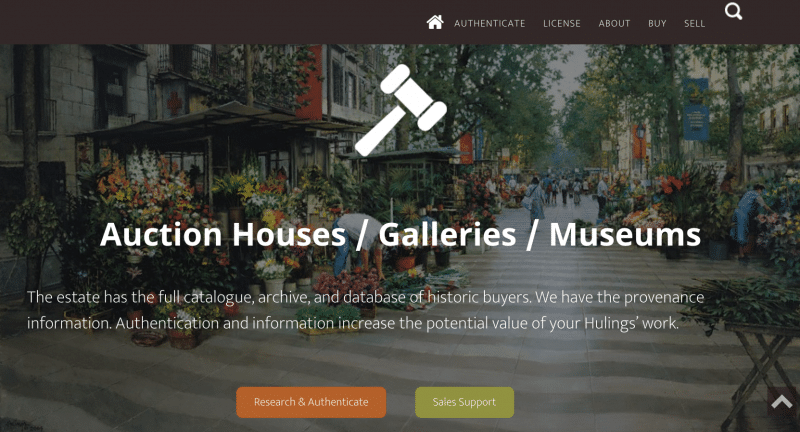
I have yet to charge anybody to use Clark Hulings’ images when they’ve asked me for them. There’s a great book coming out this fall called Pullin’ Pots: Southern Blue Crab, Recipes & Lowcountry Lore, by Pat Branning, and it contains several of my father’s Louisiana images, because they resemble the South Carolina Lowcountry. I haven’t charged the publisher because I think it’s a great thing. We’re not uptight about that stuff, but I don’t want images out on the web that can be copied and used illegally, and I certainly don’t want that happening without my knowledge.
SP: The new website strikes me as the perfect case study for everything we try to teach artists through our Business Accelerator Program. You’ve hit all the points: provenance, inventory tracking, licensing, marketing, client support, strategy, sales, etc.
EH: I’m living it, and I’ve been living it my entire life. It’s the reason I came up with this nonprofit organization to begin with. The new website is the latest iteration for how to push this business forward. It is now an estate without a living artist, but that doesn’t mean all of its business interests go away. The legacy interests are there, and they need to be pursued.
My father did a really good job of keeping track of all of his stuff. I have journals going back to 1973, and sales logs from 1960. That’s pretty good! But we’re still talking about an artist who had a really long career, and for many of those years, he had no outside representation. He did all of it himself. This is someone who would just give things to people—“Here’s a wedding present for you.” Forty years later, that piece comes out of the woodwork, and I think, “Well, I’ve never seen that before, and I don’t know who you are, but it looks like a Hulings.”
The more you know from the start, the better off you are. That’s what we preach through CHF. The work we’re doing with the estate is absolutely a living example for artists of what they can accomplish if they do the things we recommend. And it’s also a testament to the kind of nonsense they will have to deal with.
SP: What does the idea of legacy mean to you—both for living artists who are managing their own businesses, and from your perspective as the daughter of an artist?
EH: I’m a historian, that’s what I studied—history and international relations. If you don’t keep things in the public mind, they’ll be forgotten. When it comes to art, I think the legacy is two-fold. It’s making sure that the work is cared for properly so that it continues to exist, and that it’s recorded properly so that if something should happen to it, we know that it did exist, we know why it existed, and we know why it mattered. That’s for future generations who want to look at beautiful, important things, and it’s also for future artists, to get fodder for their own creations.
SP: I love that idea of a continuum. That it’s all part of the ongoing conversation among artists that started with the first cave drawings and will continue into the future, should your own son decide to become an artist someday. You’re preserving Clark’s contribution to that continuum.
EH: Absolutely. I think artists hold up a mirror. They take in everything that’s around them and then they express it visually, giving it back to whoever is looking at their work. As an historian, I want to be able to look at the art of previous generations because it’s crucial commentary. On a macro level, it’s very important.
We’ve been through a century now of modern-focused art, and that’s great. Every era has its own focus. They say the victors write the history, right? I want to make sure that all of the fantastic art of the last century is remembered.



